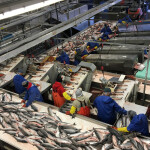A negative political campaign may win you a seat in office but not many friends. Over the past several years, the domestic catfish industry has crusaded against its chief competitors: farmed pangasius from Asia and similar species imported in increasing numbers. China's food-safety alert provided plenty of ammunition, but as domestic catfish sales drop, the attack strategy grows increasingly questionable.
A little history: In 2001, Congress - persuaded by U.S. catfish lobbyists - banned use of the word "catfish" to market species in the Pangasius family (basa, swai or tra). By that time, however, the fish had a foothold in the U.S. market due to consistent availability and low prices, up to $1 cheaper per pound than domestic catfish fillets. The measure didn't stem the tide of imports, so in 2002, the Catfish Farmers of America filed an antidumping petition against Vietnamese exporters, and won. When tariffs ranging from 37 to 64 percent were enforced, imports were nearly halved in 2003 to 5.4 million pounds (pangasius imports in 2007 topped 67 million pounds).
It was a temporary fix. Many restaurants, even in the heart of catfish country, had switched to pangasius to cut costs, and some unscrupulous suppliers took deceptive measures to evade the tariffs, calling the fish anything from grouper to sole. That's when the U.S. catfish industry changed tactics. In our August 2006 Top Story, "Collision course for catfish," Roger Barlow, president of The Catfish Institute (TCI) of Indianola, Miss., said Vietnam's Mekong River was "the toilet bowl of Asia."
The attacks haven't stopped. Last summer, in the aftermath of the food-safety crisis in China, TCI launched two brief online videos that labeled Chinese channel catfish (the same species as U.S. farmed catfish) as fare requiring HAZMAT handling, albeit with a humorous touch.
And just last week, TCI spokesman Jeff McCord, when asked about a growing movement for country-of-origin labeling at restaurants, told The Brunswick (Ga.) News that the health standards of Asian farmed fish are lower than in the United States. Then he took it a step further: "In many cases," he said, "fish are, essentially, raised in cesspools." Earlier in the week, Huntsville (Ala.) Times columnist David Prather used the same derogatory term to describe the hygiene standards of Chinese fish farms.
I called McCord yesterday, who retreated from those comments. "I overstated by saying 'cesspools.' Sometimes the most graphic comment is the one that is featured [in a news story]," says McCord. "It doesn't further civil or constructive discourse, but there is a basis for the assertion. One of the positive and important distinctions of U.S. farmed catfish is its safety and, by comparison, the pristine conditions in which it's grown."
Promoting your own product sends a better message. Negativity isnâ??t boosting sales or helping struggling catfish farmers across the country. It should stop, because the consumer impact might be the opposite of what was intended - for all catfish, domestic or imported.
Thank you,
James Wright
Assistant Editor
SeaFood Business





